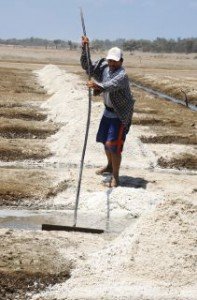 (Martes Financiero) The sun they needed salt producers in the provinces of Cocle, Herrera and Los Santos to increase production in 2010 was very intense and optimal to increase reserves.
(Martes Financiero) The sun they needed salt producers in the provinces of Cocle, Herrera and Los Santos to increase production in 2010 was very intense and optimal to increase reserves.
The rains that fell in 2009 affected both the production that left a bit bland. The Comptroller General of the Republic records that during this period the salt extracted from the ponds decreased by 7.14%.
However, in 2010 production reached 27 million kilos, an increase of 41.12% compared to 2009 when they produced 19 million kilos of salt in the country. 2010 was the best year for this sector.
One year “sweet” for producers. Since the last four years, production did not exceed 25 million kilos, like now. In 2008 this reached 21 million kilos, while in 2007 was 20 million (see graph: Production of salt).
Have excess production cooperatives
The strategy of specialists in the removal of salt was to increase storage sites.
In Los Santos, the 2010 production was 365 million pounds (16.5 million kilos), and expect that this year has the same amount of salt extracted. There he produced the greatest amount of this seasoning food, and they supply 65% of the country’s demand.
According to Modesto Delgado, general manager of the National Federation of Salt (Fencosa), even in the galley there is a stock of 100 million pounds (4.5 million kilos) of salt they were last year, when there was an “over- “. Fencosa brings together 130 producers of two cooperatives, Reyes Espino and the Santeño Salineros.
“We opened a warehouse to store 150 000 quintals (6.8 million kilos) extra, because before we had a space for 350 million pounds (15.8 million kilos), which gives us greater margins of reserves if there is an increased demand the product. ” To date, the cooperative has collected a production of 10 million pounds (453 thousand kilos), but the harvest is over.
“Produced until the rains come, for now everything is going well, because what benefits us is that it does not rain for the salt production season,” said Delgado.
In the province of Cocle also does the same. There Salinera Cooperative Campos Marín RL, which has 70 employees, has a stock of 62 million pounds (2.8 million kilos).
She produces about 162 million pounds (7.3 million kilos) a year in its two production systems, the 42 traditional salt ground floor and the plastic sheet which is placed above the ground floor. This project cost between 45 thousand and 55 thousand dollars, he says.
The investment has enabled them to become more competitive, because salt is extracted plastic cleaner than traditional.
And while Ramon Nieto, manager of the cooperative, estimated that production this year will reach 100 million pounds (4.5 million kilos) of salt, 62 million pounds (2.8 million kilos) less than last year, this is enough for demand, because last year was a surplus, which will help to supply customers.
“Last year was a blockbuster and leverage. This year there will be less, but still have much in the cellar, “says Nieto.
On the other hand, Sarigua Cooperative, in Herrera, the 31 producers that brings this entity working on one project where they use plastic sheeting. Though smaller producers in the country, they supply the livestock sector, industrial and ice house [is used for ice last longer]. Crude salt pack for these sectors and production reaches the 81 million pounds (3.6 million kilos).
One of the biggest consumers of salt is the livestock sector. Euclides Diaz, executive secretary of the National Cattlemen’s Beef Association estimates that each animal consumes 1.9 kilo of salt per year, that daily consumption of cattle is 30 grams which is mixed with mineral phosphorus, calcium, fluorine and zinc. Currently, the cattle herd has reached one million 600 thousand heads.
“We use salt as a vehicle to carry the minerals that do not arrive directly from the grass,” he says.
But they are not unique, the tuna boats, the leather industry and processing plants are also high consumers of this product so far seems to have a sweet moment.